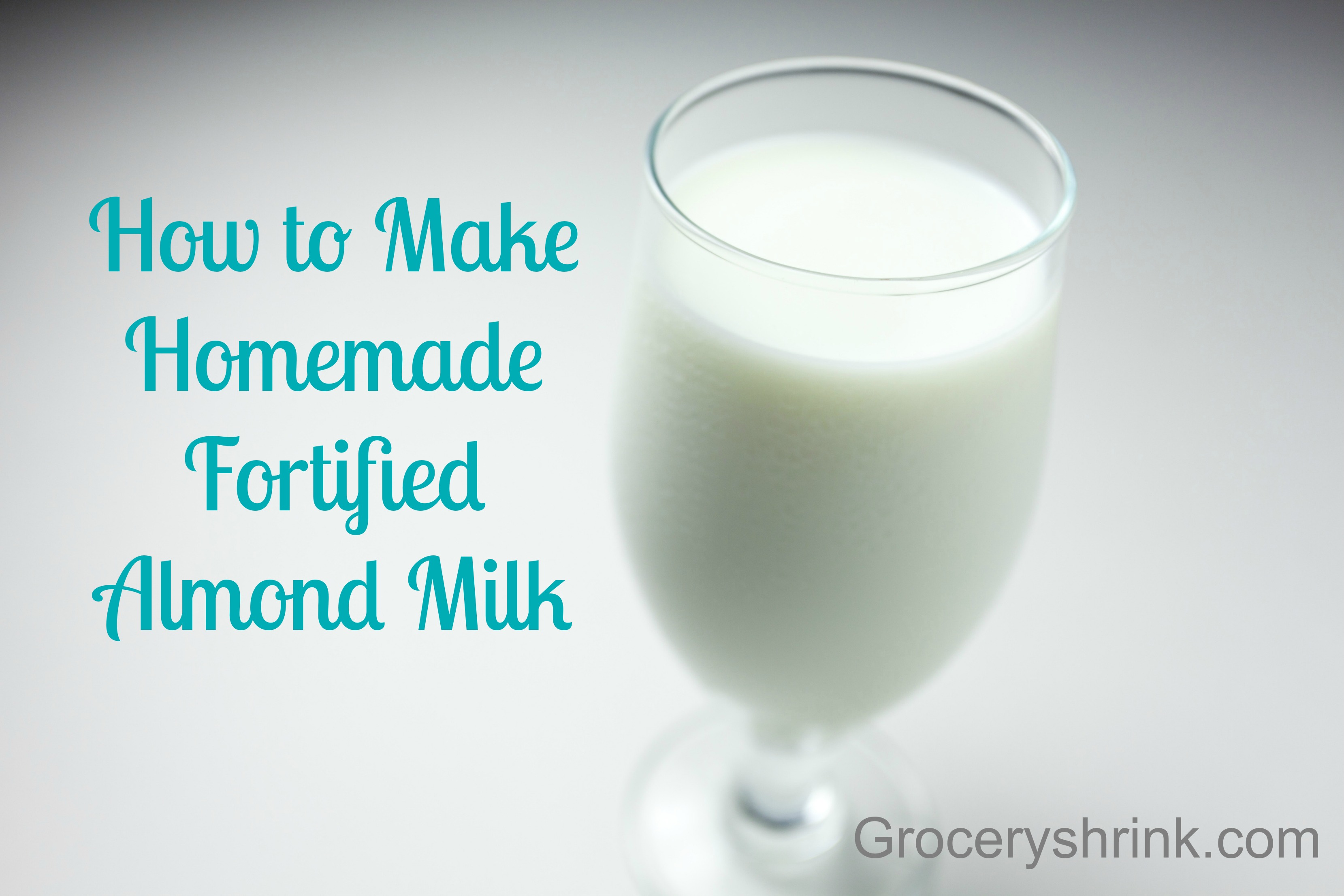
I turned my nose up at vegan milks for years. Real milk has protein and calcium, it’s affordable, and tastes great. Why mess with a good thing?
Then I met up with the symptoms of lactose intolerance. Sometimes I could eat dairy products without consequence and sometimes I would be doubled over in pain. It was like a dietary game of Mumblety peg.
Almond milk sparked my interest when I found out it only has 30 calories per cup, is low in carbs and tastes pretty good. It boasts a good serving of calcium, but only because it is added artificially. This is not a drink for babies or kids unless the diet has other rich sources of fats or protein.
Almond milk makes good smoothies, custards, cream soups, cream gravy, and fettuccini sauce. It costs about $3 for a half gallon, or $6 a gallon. The cost is about 50% more than regular milk. My children do not show signs of lactose intolerance or milk allergy so I do not feed them almond milk.
It’s not hard to make homemade almond milk and homemade costs quite a bit less than store bought–PLUS Almond flour is a by-product of almond milk production. That’s good news for low carb and gluten free bakers everywhere.
At Costco, almonds are $15 for 3 pounds. (Or almonds that haven’t been treated with fungicide are available at Trader Joes for $6 a lb.) It takes 2 oz of almonds to make a half gallon of milk. So one 3 lb bag of almonds makes 24 half gallons (plus almond flour) at $.62 each. If you want fortified almond milk that has the same nutrition as milk, you will want to add 8 calcium, magnesium, vitamin d3 tablets.
Adding vitamins adds to the cost slightly. These tablets* are $.07 each and I would need 8 of them to create a homemade nutritional profile comparable to store bought almond milk. Homemade fortified almond milk is $1.18 per half gallon vs $3.28 for store bought for a savings of $2.10.
Here’s how to make your own almond milk.
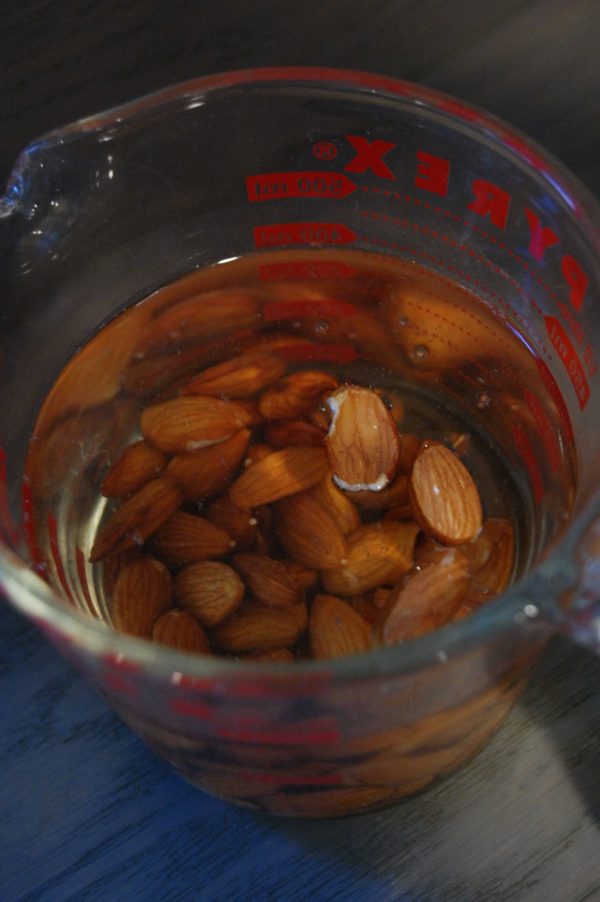
Measure 1/4 cup of almonds into a class cup and cover with twice as much water. 1/4 cup of almonds makes 1 quart of milk. 1/2 cup makes half a gallon–the same as in the typical grocery store carton. Let stand for 8 hours or overnight.
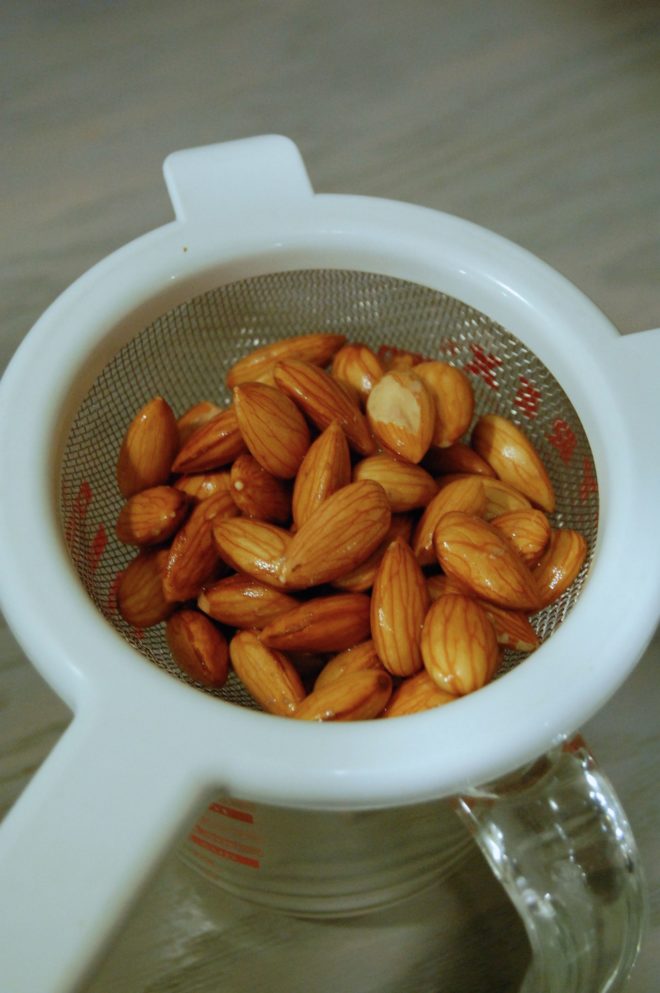
After 8 hours, drain your almonds, then place in a blender. Add a generous pinch of sea salt and any supplements or flavors (like vanilla and honey or stevia) you are adding. I used 4 calcium tablets so each cup of milk would have 30% RDA of calcium, plus magnesium and vitamin D3.
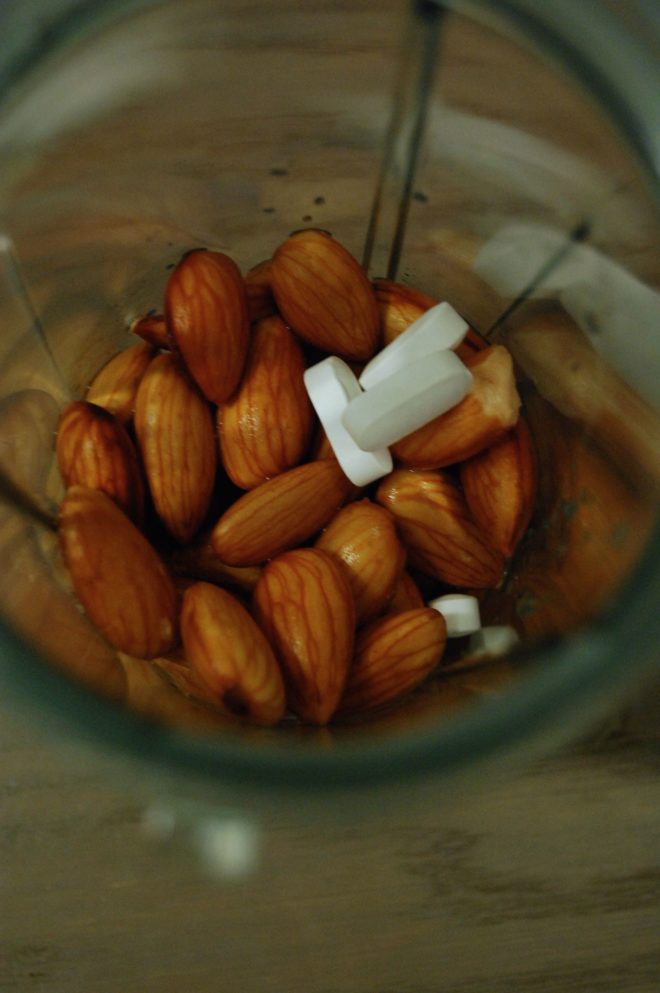
Cover with just enough fresh water to keep the blades running smoothly. Too much water will allow the almonds to get away from the blades and not grind as fine.

Blend for a couple of minutes until the nuts are all ground up into tiny bits.
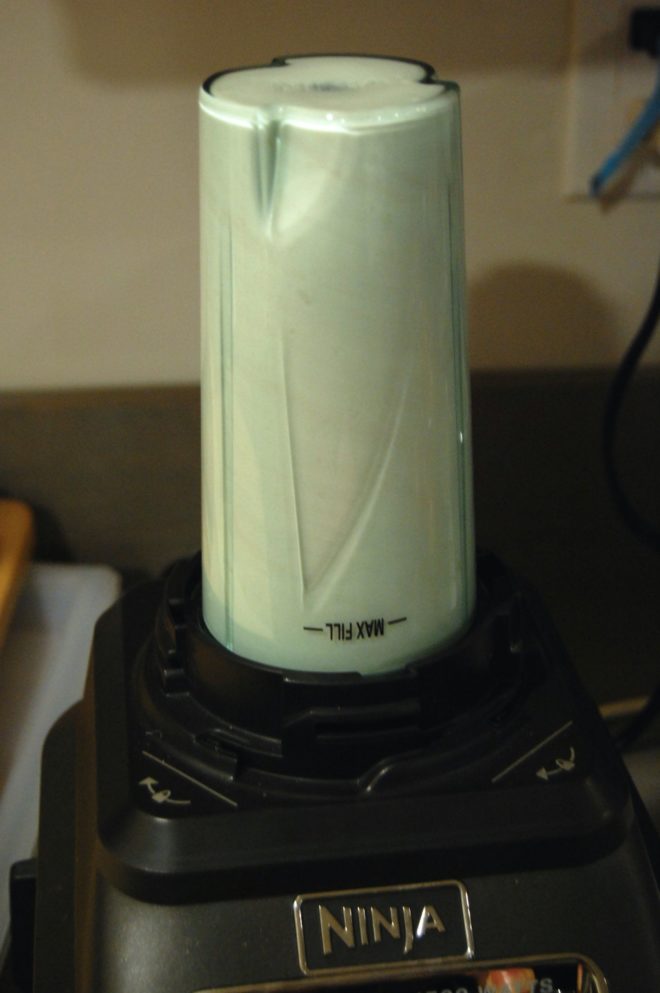
Strain though a nut bag (I use a huge straining bag that I purchased for Kombucha.) Amazon* has nut bags also, or you could use cheese cloth, a clean flour sack towel, or even a coffee filter. They all work, but the nut bag is fastest and easiest. At the end, give the mass of ground nuts a good squeeze to get as much water out as possible.
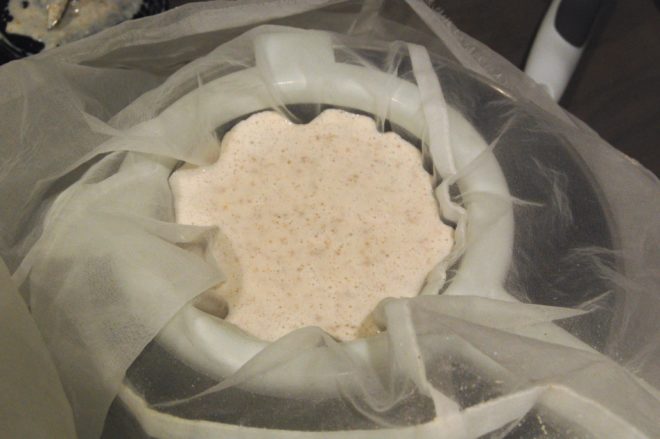
Pour the strained milk into a canning jar.
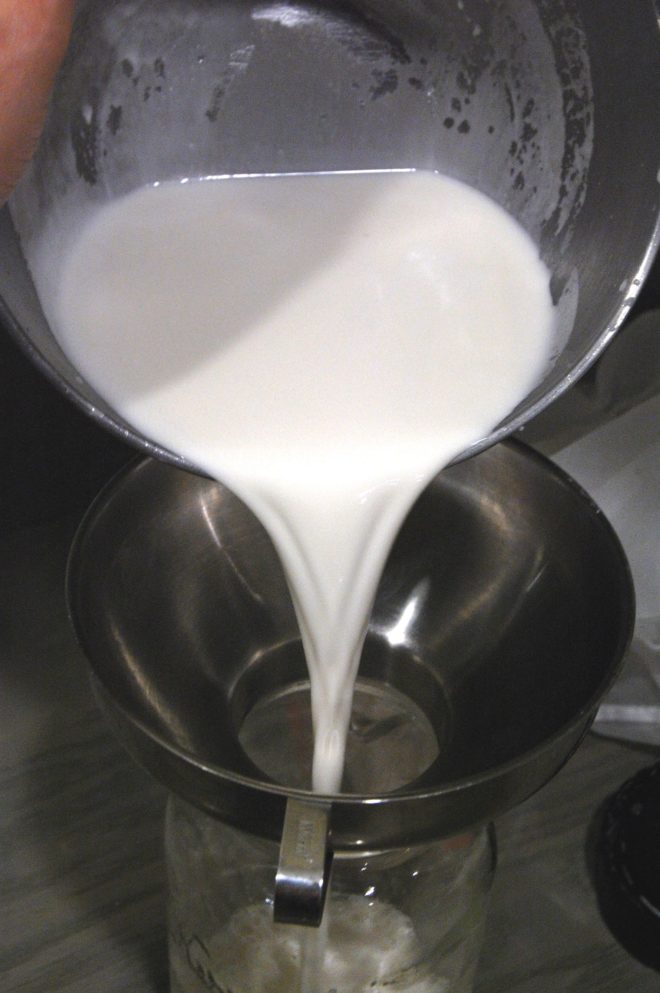
Pour in enough fresh water to make a quart, or half gallon–whatever you used enough nuts for.
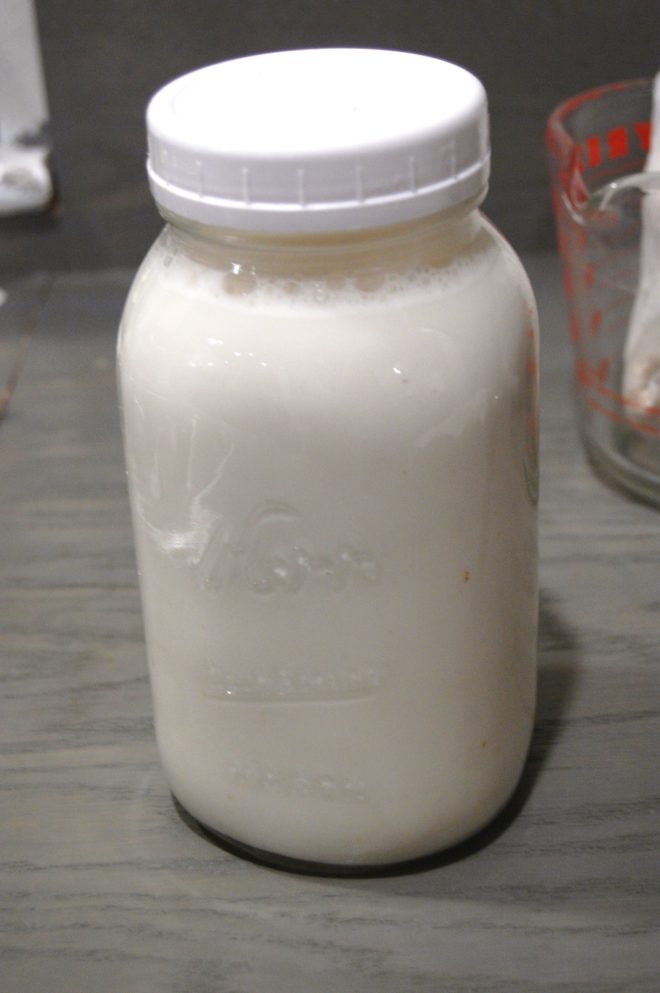
Voila!
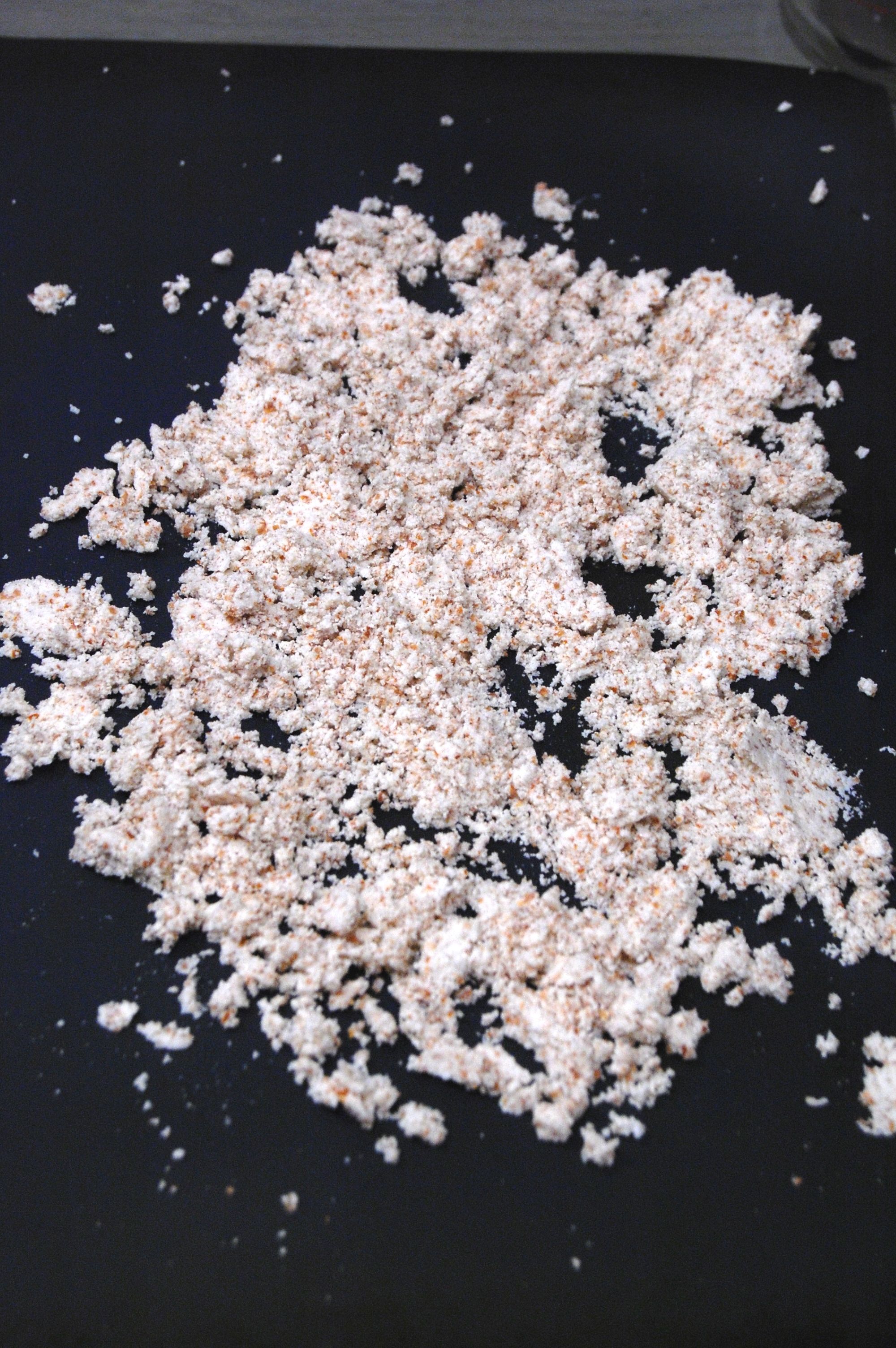
Now scrape the nut meal out of your straining bag (or whatever you used.) Spread it onto a silicone mat, wax paper or parchment. Let it dry thoroughly. (In the dry weather, mine dries overnight.) If it’s humid, you can spread it on a cookie sheet and bake at 200 degrees for 2 hours. Then turn off the oven and let it stay in there for a few hours more. Transfer the dry stuff back to a clean dry blender cup and pulverize it super fine. Use it as you would any almond flour.
Q. How long does the almond milk last?
A. If you are using raw almonds it will go “sour” in 3-4 days. Costco’s almonds are blanched and the milk lasts longer. I’ve gone a week and it was still fine. It’s never lasted longer than that, so I can’t say when it sours.
Q. Shouldn’t you remove the skins from the almonds first?
A. Who’s got time for that? The milk tastes great either way. With the skins on the almonds, the almond flour will have flecks of color in it, compared to commercial almond flour which is just white. I haven’t noticed a difference in performance between the two flours. And the almond milk comes out white either way.
Q. I don’t like almonds. Can I do this with other nuts?
A. Yes. Cashews and sunflower seeds work especially well. Let me know if you try it :).
More questions? Concerns? Put them below. Have you ever made your own almond milk?
* P.S. The Amazon links are for your benefit only and are not affiliate links. As a Missouri resident I am not eligible to be an Amazon Affiliate.
Thank you for this post! My husband has a dairy allergy and I use almond milk to make almost everything we eat; but the expense is really hard on our grocery budget. I can’t wait to give this a try!
Jennifer, I’m glad it’s helpful to you. Commercial milk has thickeners in it, so if you’re used to that you can use 1/4 tsp of glucomannan or xanthan gum to thicken and stabilize the milk. I don’t mess with it, but shake mine well before using. It can separate in the fridge, but that’s normal. N\
Do you need a special blender? And how long will the flour last? If I understand right, I would only yield a quarter cup of flour, so I would need to store it until I had enough to make something…? Hoping I don’t need a special blender–soaking my almonds now!
I used a mini blender to make mine (like a magic bullet.) The flour is dry so will last a long time. You can keep it in the fridge if you prefer to help it last longer. Happy milk making!
So you put the Calcium supplements in the blender with almonds and blend or so you crush
Pat, yes. You’ll need to blend them up so they crush. It helps to let it stand in the blending water a little bit so they soften. I’m not sure on the brand. I just used some stuff we had on hand. You might want to see which kind aborbs the best for human use.
What kind of brand of calcium product you use when making almond milk
Hello,
I am making homemade almond milk due to food/dairy allergies. What kind of calcium tablets you recommend? Are you a nutritionist? I really need to know. I asked this question before but I never heard back from you. Thanks.
P.s I am not a nutritionist. Just a mom who reads.
Angela,
Sorry for the duplicate post. I thought you were going to reply to my email. Why not use the powder form of calcium.
Patricia, I just used what I had on hand. If you have powder go for it!
very good information for to go one step ahead for commercial milk production.
Thank you for all the info about fortification. I’m gonna use it. I try to stay away from dairy and I’ve been making my own almond milk for years. However my ratio of almond for each liter is different: I use a whole cup of almonds for 1 liter of almond milk. Your almond milk is very diluted! But hey… if you like it. I used to blend the almonds with their skin, but now I take it off. It just takes 5 minutes or so and it’s better because of the phytates in the almond skin.
Thanks for your input! My almond to water ratio is figured to give the 30 calories per cup macros like store bought milk. You are welcome to make it more concentrated for sure.
I add some chia seeds to my nut milks. About a tablespoon gives it a nice texture and adds a little more nutrition
Tess, that’s such a great idea.
If you put the calcium supplements in before you separate the nut pulp wont you lose some of the supplements?
If the calcium is fully dissolved it will go through the strainer.